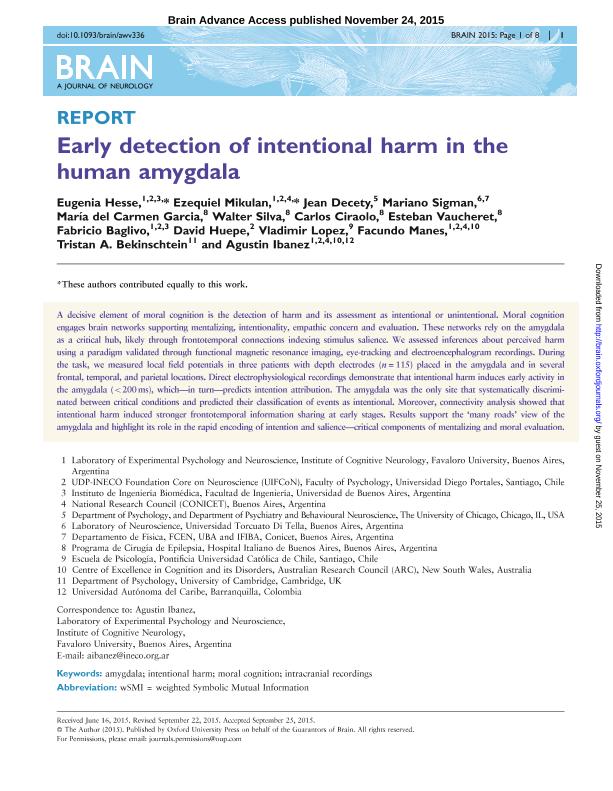Artículo
Early detection of intentional harm in the human amygdala
Hesse Rizzi, Eugenia Fátima ; Mikulan, Ezequiel Pablo
; Mikulan, Ezequiel Pablo ; Decety, Jean; Sigman, Mariano
; Decety, Jean; Sigman, Mariano ; Del Carmen Garcia, María; Silva, Walter; Ciraolo, Carlos; Vaucheret, Esteban; Baglivo, Fabricio; Huepe, David; Lopez, Vladimir; Manes, Facundo Francisco
; Del Carmen Garcia, María; Silva, Walter; Ciraolo, Carlos; Vaucheret, Esteban; Baglivo, Fabricio; Huepe, David; Lopez, Vladimir; Manes, Facundo Francisco ; Bekinschtein, Tristán Andrés
; Bekinschtein, Tristán Andrés ; Ibañez, Agustin Mariano
; Ibañez, Agustin Mariano
 ; Mikulan, Ezequiel Pablo
; Mikulan, Ezequiel Pablo ; Decety, Jean; Sigman, Mariano
; Decety, Jean; Sigman, Mariano ; Del Carmen Garcia, María; Silva, Walter; Ciraolo, Carlos; Vaucheret, Esteban; Baglivo, Fabricio; Huepe, David; Lopez, Vladimir; Manes, Facundo Francisco
; Del Carmen Garcia, María; Silva, Walter; Ciraolo, Carlos; Vaucheret, Esteban; Baglivo, Fabricio; Huepe, David; Lopez, Vladimir; Manes, Facundo Francisco ; Bekinschtein, Tristán Andrés
; Bekinschtein, Tristán Andrés ; Ibañez, Agustin Mariano
; Ibañez, Agustin Mariano
Fecha de publicación:
01/2016
Editorial:
Oxford University Press
Revista:
Brain
ISSN:
0006-8950
Idioma:
Inglés
Tipo de recurso:
Artículo publicado
Clasificación temática:
Resumen
A decisive element of moral cognition is the detection of harm and its assessment as intentional or unintentional. Moral cognition engages brain networks supporting mentalizing, intentionality, empathic concern and evaluation. These networks rely on the amygdala as a critical hub, likely through frontotemporal connections indexing stimulus salience. We assessed inferences about perceived harm using a paradigm validated through functional magnetic resonance imaging, eye-tracking and electroencephalogram recordings. During the task, we measured local field potentials in three patients with depth electrodes (n = 115) placed in the amygdala and in several frontal, temporal, and parietal locations. Direct electrophysiological recordings demonstrate that intentional harm induces early activity in the amygdala (5 200 ms), which-in turn-predicts intention attribution. The amygdala was the only site that systematically discriminated between critical conditions and predicted their classification of events as intentional. Moreover, connectivity analysis showed that intentional harm induced stronger frontotemporal information sharing at early stages. Results support the 'many roads' view of the amygdala and highlight its role in the rapid encoding of intention and salience-critical components of mentalizing and moral evaluation.
Palabras clave:
Amygdala
,
Intentional Harm
,
Intracranial Recordings
,
Moral Cognition
Archivos asociados
Licencia
Identificadores
Colecciones
Articulos(IFIBA)
Articulos de INST.DE FISICA DE BUENOS AIRES
Articulos de INST.DE FISICA DE BUENOS AIRES
Articulos(SEDE CENTRAL)
Articulos de SEDE CENTRAL
Articulos de SEDE CENTRAL
Citación
Hesse Rizzi, Eugenia Fátima; Mikulan, Ezequiel Pablo; Decety, Jean; Sigman, Mariano; Del Carmen Garcia, María; et al.; Early detection of intentional harm in the human amygdala; Oxford University Press; Brain; 139; 1; 1-2016; 54-61
Compartir
Altmétricas



